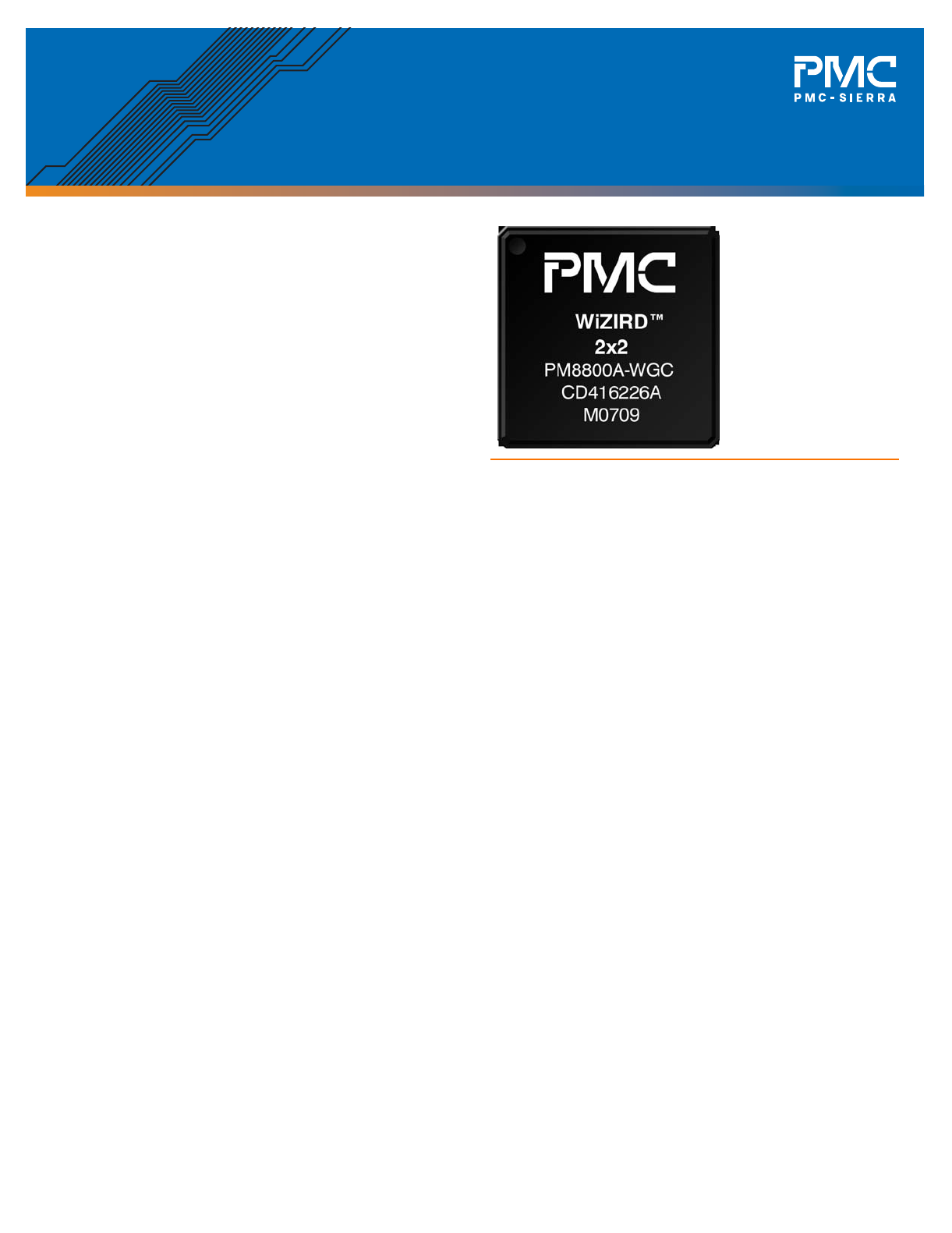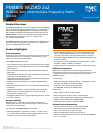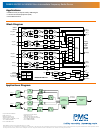
PM8800 WiZIRD 2x2
PMC-2061867, Issue 8
© Copyright PMC-Sierra, Inc., 2008
All rights reserved. Proprietary and Confidential to PMC-Sierra, Inc. and for its customers’ internal use.
WiMAX Zero Intermediate Frequency Radio
Device
Product Overview
The PM8800 WiZIRD 2x2 is an ultra-integrated single-chip WiMAX
Zero Intermediate Frequency (ZIF) Radio Device. It is designed for
Fixed and Mobile WiMAX applications and supports both IEEE
802.16-2004 and IEEE 802.16e-2005 standard requirements. The
PM8800 WiZIRD 2x2 has two independent radio paths (2Tx and
2Rx) and supports operation in the 2.3 - 2.9 GHz or the
3.3 - 3.8 GHz licensed bands.
The PM8800 WiZIRD 2x2 enables manufacturers of WiMAX Femto
BS, CPE, and MS User Equipment to build low-cost, high-perfor-
mance, 2x2 MIMO equipment today.
Product Highlights
Ultra-Integration
Integration of key transmit and receive path components dramat-
ically reduces the cost of materials and manufacturing, at the
same time improving system reliability.
The PM8800 WiZIRD 2x2 features:
• Two independent radio paths (2Tx and 2Rx) supporting all Wave
2 MIMO features and enabling the radio path for uplink MIMO
enhancements
• Zero-IF architecture removes the cost associated with external
SAW filters
• Integrated DCXO supports AFC with no additional components,
except for a low-cost 40 MHz crystal
• Integrated synthesizer loop filter improves noise immunity and
reduces board space requirements
• 40 MHz reference is available for use by the Baseband MAC
Processor
• Diagnostic loopback circuits for radio calibration and baseband
diagnostics
• Integrated DAC/ADCs for digital I/Q designs allow Baseband
MAC Processors to scale with Moore's Law without being
burdened with analog circuits
• Integrated transmit baluns, digital temperature monitor, and Rx
DC offset capability
Design Flexibility
Design flexibility is essential for equipment manufacturers,
allowing them to react and adapt to changes in market require-
ments with minimal changes.
For flexibility, the PM8800 WiZIRD 2x2 includes:
• Multi-band support for operation in the 2.3 - 2.9 GHz or the
3.3 - 3.8 GHz licensed bands, enabling system designs that are
suitable for use across multiple geographies
• The choice of selecting an analog or digital I/Q interface to an
external Baseband MAC Processor. This lets designers use the
best-in-class Baseband MAC Processor or ASIC available both
now and in the future. The digital I/Q interface is compliant
with JEDEC JESD207, Radio Front End - Baseband Digital Parallel
Interface standard.
• Configurable channel bandwidths of 3.5 MHz, 5 MHz, 7 MHz,
8.75 MHz, 10 MHz, 14 MHz, and 20 MHz
• Programmable transmitter gain control for mobile applications
Reliable Performance
PMC-Sierra has supplied and supported high performance
semiconductor solutions to the communications industry for over
a decade. The same performance philosophy applies to our
WiMAX products.
Transmit Path
• EVM (measured after integrated balun): -36 dB @Pout = 0 dBm
(2.5 GHz), -34 dB @Pout = 0 dBm (3.5 GHz)
• Tx power control range: 70 dB (1 dB steps)
• -77 dBm/MHz noise floor at 70 MHz offset
Receive Path
• EVM: -36 dB (2.5 GHz), -34 dB (3.5 GHz)
• RFIC noise figure: 2.9 dB (2.5 GHz), 3.3 dB (3.5 GHz)
• Rx gain control: 93 dB range (1.5 dB steps), 106 dB max gain
• Adjacent channel rejection: 26 dB (64 QAM)
• Alternate channel rejection: 34 dB (64 QAM)
General Device Information
• Control interface conforms to industry standard SPI
specifications used by Baseband MAC Processors
• 1.8V ± 5% and 2.5V ± 5% supply voltages
• Industrial temperature range (-40 °C to +85 °C)
• 108-pin Dual Row 0.65 mm pitch Micro Lead Frame (MLF/QFN)
(11 x 11 mm body)
Released Product Brief




